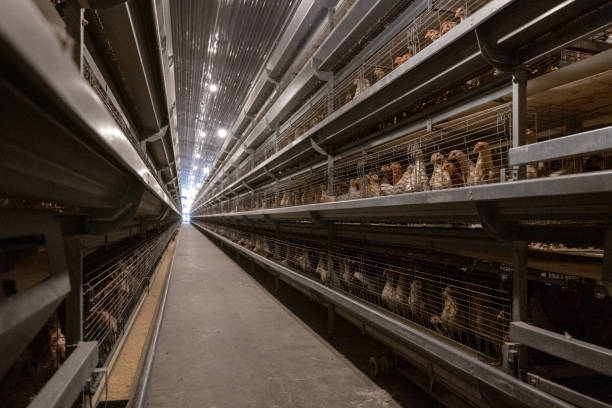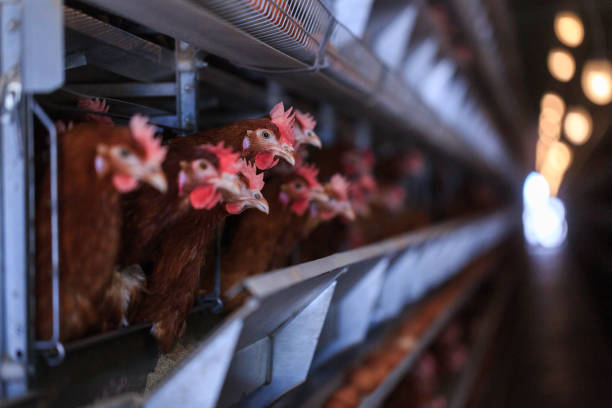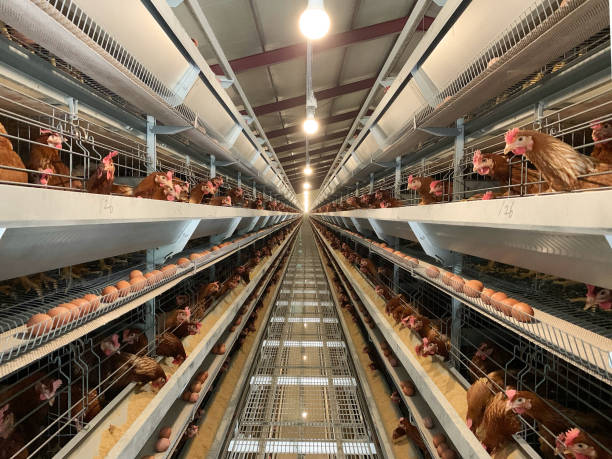
Scaling Up: Best Practices for Broiler Cage Management of 30,000 Birds in South Africa
Scaling Up: Best Practices for Broiler Cage Management of 30,000 Birds in South Africa
Successfully managing a broiler operation of 30,000 birds in South Africa requires a keen understanding of poultry management principles, combined with practical strategies tailored to the local environment and market conditions. Whether you’re expanding an existing farm or starting a new venture, implementing best practices from the outset will be crucial for profitability and sustainability. This article provides a comprehensive guide to broiler cage management, covering key areas from cage design and environmental control to feeding, health management, and waste disposal.
Cage Design and Space Management
Choosing the right cage system and managing space appropriately are fundamental to broiler welfare and performance.
Cage System Selection: Select broiler cages specifically designed for efficient space utilization, ease of cleaning, and bird comfort. Consider the following factors:
Material: Galvanized steel is the standard due to its durability, resistance to corrosion in humid environments, and ease of cleaning.
Cage Dimensions: Ensure cages provide adequate space per bird, adhering to South African regulations and industry best practices. Overcrowding leads to stress, disease outbreaks, and reduced growth rates. A general guideline is to provide at least 450-500 square centimetres (70-77 square inches) per bird.
Flooring: Opt for wire mesh flooring that allows for proper manure drainage and promotes better hygiene. Ensure the mesh size is appropriate to prevent foot injuries.
Accessibility: Cages should be designed for easy access for feeding, watering, and bird handling.
Tier System: Multi-tiered cage systems can maximize space utilization in your broiler house. Ensure proper ventilation and lighting on all tiers.
Space Allocation: Overcrowding is a major problem in broiler production. It leads to:
Increased stress and aggression: Birds may compete aggressively for food and water, leading to injuries and uneven growth.
Higher disease incidence: Densely populated environments facilitate the rapid spread of diseases like coccidiosis and respiratory infections.
Reduced feed conversion efficiency: Stressed birds don’t convert feed as efficiently, leading to higher production costs.
Poor air quality: Overcrowding contributes to increased ammonia levels and poor ventilation, further compromising bird health.
Environmental Control: Temperature, Ventilation, and Lighting
Maintaining optimal environmental conditions is central to broiler health and productivity.
Temperature Management: Broilers are highly sensitive to temperature fluctuations, particularly in their early stages.
Brooding Phase (Days 1-7): Maintain a brooding temperature of 32-35°C (90-95°F) at bird level. Observe bird behaviour to fine-tune temperature settings. Chicks that are too cold will huddle together, while those that are too hot will pant and spread out.
Growing Phase (Days 8-Maturity): Gradually reduce the temperature to around 21-24°C (70-75°F) as the birds mature. Monitor temperature regularly using accurate thermometers and adjust as needed.
Factors Affecting Temperature: Consider external factors such as seasonal changes, building insulation, and ventilation system efficiency. In South Africa, summer temperatures can be extreme, requiring advanced cooling systems.
Cooling Systems: Evaporative cooling systems (pad and fan systems, foggers) are effective in hot, dry climates. Ensure proper maintenance and regular cleaning to prevent the spread of diseases like aspergillosis.
Ventilation: Proper ventilation is essential for removing excess moisture, ammonia, and carbon dioxide, and for maintaining air quality.
Natural Ventilation: Relying on natural airflow through windows and vents. This is less reliable in controlling air quality and temperature, especially during extreme weather.
Mechanical Ventilation: Using fans to control airflow. This offers greater control and consistency. Consider tunnel ventilation (fans at one end of the house pulling air through) or cross-ventilation (fans on the side walls).
Minimum Ventilation: Even in cold weather, maintain minimum ventilation to remove harmful gases and replenish oxygen.
Air Quality Monitoring: Regularly monitor ammonia levels using a handheld meter. Aim to keep ammonia levels below 25 ppm.
Lighting Programs: Lighting plays a crucial role in broiler growth and development.
Brooding Period: Provide continuous lighting (23 hours light, 1 hour dark) during the first few days to encourage feeding and drinking.
Growing Period: Implement a lighting program that includes periods of darkness to improve feed conversion efficiency and reduce leg problems. A common program is 16 hours light and 8 hours dark.
Light Intensity: Adjust light intensity to optimize bird activity and prevent stress. Use dimmable LED lights to control light intensity efficiently.
Light Color: Research suggests that certain light colors (e.g., blue light) may have a calming effect on broilers, reducing aggression and improving growth rates.
Feeding and Watering Strategies
Optimal nutrition and access to clean water are crucial for maximizing broiler growth and preventing health problems.
Feed Management:
Feed Formulation: Work with a reputable feed supplier to formulate a feeding program tailored to the specific needs of your broiler breed and age. A typical program includes starter, grower, and finisher feeds.
Feed Quality: Ensure the feed is fresh, free from contaminants (e.g., mycotoxins), and properly stored to prevent spoilage.
Feeding System: Choose a feeding system that minimizes feed wastage and ensures even distribution of feed throughout the cages. Options include trough feeders, chain feeders, and automatic feeding systems.
Feeding Frequency: Adjust feeding frequency based on the age and needs of the birds. Young chicks require more frequent feeding to support rapid growth.
Water Management:
Water Quality: Provide clean, fresh water at all times. Regularly test water quality for bacteria and contaminants. Consider installing a water filtration system.
Watering System: Nipple drinkers are a popular choice for broiler cages as they minimize water wastage and contamination. Ensure the drinkers are properly adjusted to prevent leaks.
Water Availability: Provide adequate drinker space to ensure all birds have access to water. As a general guideline, provide at least one nipple drinker per 10-12 birds.
Water Temperature: In hot weather, consider cooling the water slightly to encourage birds to drink more.
Health Management and Biosecurity
Preventing disease outbreaks is paramount in a large broiler operation.
Biosecurity Measures:
Farm Location: Choose a farm location that is isolated from other poultry farms and potential sources of contamination.
Visitor Control: Restrict access to the farm to essential personnel only. Implement a strict visitor log and require visitors to wear protective clothing (boots, coveralls).
Sanitation: Maintain a rigorous sanitation program. Regularly clean and disinfect all equipment, cages, and facilities.
Foot Baths: Place foot baths containing disinfectant at all entrances to the broiler house.
Rodent and Pest Control: Implement a comprehensive rodent and pest control program. These pests can carry diseases and contaminate feed.
Vaccination Programs:
Develop a vaccination program in consultation with a veterinarian. Common vaccines include those for Newcastle disease, infectious bronchitis, and Gumboro disease.
Administer vaccines according to the recommended schedule.
Keep accurate records of all vaccinations.
Disease Monitoring:
Monitor birds closely for signs of illness (e.g., lethargy, ruffled feathers, decreased appetite, respiratory distress).
Submit sick or dead birds to a veterinary diagnostic laboratory for analysis.
Implement prompt treatment measures to control outbreaks.
Medication:
Use antibiotics judiciously and only under the guidance of a veterinarian. Overuse of antibiotics can lead to antibiotic resistance.
Keep accurate records of all medications administered.
Observe withdrawal periods before slaughtering birds that have been treated with medication.
Waste Management

Proper waste disposal is essential for environmental sustainability and preventing disease.
Manure Handling:
Manure Removal: Regularly remove manure from the cages to reduce ammonia levels and improve air quality.
Manure Storage: Store manure in a designated area away from the broiler house. Ensure the storage area is properly covered to prevent runoff and odour emissions.
Manure Treatment: Consider composting manure to reduce volume, stabilize nutrients, and kill pathogens. Composted manure can be used as fertilizer.
Dead Bird Disposal:
Dispose of dead birds promptly and properly. Options include incineration, composting, and burial.
Follow local regulations regarding dead bird disposal.
Water Management:
Minimize water wastage to reduce the volume of wastewater generated.
Treat wastewater before discharge to remove contaminants.
Record Keeping and Data Analysis
Maintaining accurate records is crucial for monitoring performance, identifying problems, and making informed decisions.
Key Performance Indicators (KPIs):
Mortality Rate: Track mortality rates weekly to identify potential health problems.
Feed Conversion Ratio (FCR): Monitor FCR to assess feed efficiency.
Average Daily Gain (ADG): Track ADG to assess growth performance.
Body Weight: Monitor body weight regularly to ensure birds are meeting growth targets.
Water Consumption: Track water consumption daily to identify potential health problems or leaks in the watering system.
Data Analysis:
Analyze data regularly to identify trends and patterns.
Use data to make informed decisions about feeding, ventilation, and health management.
Benchmark your performance against industry standards.
Staff Training and Management
Well-trained and motivated staff are essential for the success of any broiler operation.
Training Programs:
Provide comprehensive training to all staff on broiler management practices, biosecurity protocols, and emergency procedures.
Offer ongoing training to keep staff up-to-date on the latest best practices.
Employee Engagement:
Foster a positive work environment.
Provide opportunities for advancement.
Recognize and reward good performance.
Adapting to the South African Context

Managing a broiler operation in South Africa presents unique challenges and opportunities.
Climate Considerations: South Africa experiences a wide range of climates, from hot and arid to temperate. Adapt your management practices to the specific climate in your region.
Economic Factors: Consider the cost of feed, energy, and labor when making management decisions.
Market Dynamics: Understand the local market for broiler meat. Identify opportunities to differentiate your product and add value.
Regulatory Compliance: Ensure you comply with all relevant South African regulations regarding poultry production, animal welfare, and environmental protection.
By consistently implementing these best practices, you can create a successful and sustainable broiler cage operation of 30,000 birds in South Africa, thereby contributing to food security and economic growth in the region. Remember that continuous learning, adaptation, and a commitment to excellence are the keys to long-term success.
